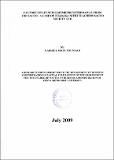| dc.description.abstract | While Savings and Credit Cooperative Societies (saccos) are an autonomous associations of persons untied voluntarily to meet their economic and social needs, their survival has been threatened by competition from mainstream commercial banks. Saccos are affected by high loan delinquencies and poor management in spite of having mobilized reasonable amount of funds due to lack of regulatory framework to guide their operations. Recent concern has been that members withdraw from the saccos due to high loan demand. How to cope with the members withdrawal from the sacco is the focus of this paper, especially after acquiring credit facility from the commercial banks. The research has been descriptive in nature and involves revealing of the main challenges being faced by saccos. The research has used questionnaires and interview schedules. The population for this study is 4000 sacco member, 250 teachers who have left the society and 14 members of staff It was found that members go for bank loans because banks advance big amount of loans than saccos. The high interest rates offered by banks did not deter members' move to banks for loaning. The study concludes that saccos face stiff competition in their business operations. Commercial banks have strong capital base, thus buying sacco members loans. This weakens the sacco operations affecting their performance. | en_US |

